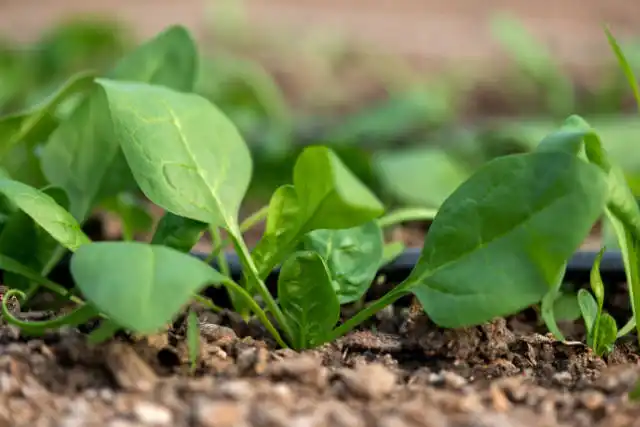Spinach is a cool-season vegetable. Growing spinach is a fantastic way to enjoy fresh, nutritious greens straight from your garden.
Spinach is a fast growing plant making it perfect for beginner gardeners. It doesn’t take much space, so it can be grown in containers, raised beds or directly in the ground. Spinach can be used in a variety of dishes including salads, smoothies and baking (think frittatas and quiches).
This post may contain affiliate links. Please read our disclosure policies. If you purchase after clicking an affiliate link, we may receive small commission at no cost to you. As an Amazon Associate, I earn from qualifying purchases. All opinions remain our own.
When and How to Plant Spinach
Spinach is a cool-season vegetable. Plants prefer a soil temperature to be between 50°F and 60°F degrees. Depending on your gardening zone, spinach can be planted in the spring and in the fall.
Spring Planting
Plant your spinach seeds as soon as the soil can be worked in early spring, usually around 4-6 weeks before the last expected frost date.
Fall Planting
For a fall harvest, sow spinach seeds 6-8 weeks before the first expected frost. This timing allows the plants to establish before the cold weather sets in.
Sow seeds under a half an inch of soil and space 6 inches apart and in rows 12 inches apart. Seedlings should appear in two weeks.
When to Plant Spinach in Arizona
In Phoenix or gardening zone 9b plant spinach September through February.
If you’re growing spinach in the Prescott or Sedona area plant in mid-February through mid April or September to October.
How to Plant Spinach
Spinach grows best in cool weather and can tolerate some shade, especially in warmer climates. The ideal temperature for spinach is between 45-75 degrees.
In warmer climates, provide some afternoon shade can help prevent the plants from bolting and going to seed prematurely.
Amend the soil with compost to improve fertility and drainage. Ensure the soil is loose and well-aerated.
Plant seeds directly in the garden, spacing them about 1 inch apart and covering with 1/2 inch of soil. Water gently to settle the soil.
Spinach will sprout in 7-14 days. Plant 6-8″ apart.
Types of Spinach
Spinach comes in several varieties, each with unique characteristics.
Savoy Spinach or Crinkly Leaf Spinach
This type features crinkly, dark green leaves that are highly textured. It is cold-hardy and can withstand frost, making it ideal for early spring and late fall planting. Some varieties include: Bloomsdale, Tyee, and Regiment.
Smooth Leaf Spinach
With smooth, flat leaves, this type is easy to clean and ideal for fresh salads and cooking. Smooth-leaf varieties grow quickly and are less prone to bolting in warmer weather. Some varieties include: Tundra, Space, and Corvair.

Semi- Savoy Spinach
A hybrid between savoy and smooth-leaf spinach, semi-savoy varieties have slightly crinkled leaves. They offer good disease resistance. Some varieties of semi-savoy spinach includes Regal and Avon.
Companion Plants for Spinach
Companion planting involves growing certain plants together for mutual benefit. Spinach benefits from companions that help deter pests and improve growth. Good companions for spinach include: Lettuce, peas, radishes and strawberries.
Both lettuce and spinach have similar growing conditions. Growing peas next to spinach can help improve the nitrogen in the soil. Strawberries.and radishes both grow well with spinach.
How to Care For Spinach
Light Requirements: Spinach needs full sun or about 6-8 hours of sun a day. In warmer climates, like Phoenix, providing some afternoon shade can help prevent the plants from bolting and going to seed prematurely.
Soil Requirements: Prefers fertile well-drained loose soil. Spinach prefers slightly acidic pH. The soil pH range of 6- 7 is ideal. Spinach thrives in well-drained, fertile soil rich in organic matter. Adding compost or aged manure to the soil will improve its structure and fertility, ensuring healthy spinach growth.
Water Requirements: Spinach likes consistent moisture. Provide 1″ of water per week or as needed. Aim to keep the soil consistently moist, providing about 1 inch of water per week. Adjust your watering schedule based on rainfall and temperature. Avoid letting the soil dry out completely, as this can stress the plants and reduce yields.
When to Harvest Spinach
Spinach is a relatively fast-growing crop. Depending on the variety and growing conditions, you can expect to harvest your spinach within 30-45 days from planting. Baby spinach leaves are ready to pick in about 20 days, making it a quick and rewarding crop for any garden.
Spinach is ready to harvest when the leaves are large enough to eat. Baby spinach can be harvested about 20-30 days after planting, while mature leaves are ready in 30-45 days. Harvest the outer leaves first, allowing the inner leaves to continue growing for multiple harvests.
How to Harvest
Use a pair of scissors or garden shears to cut the outer leaves about an inch above the base. Continue harvesting regularly to encourage new growth.
Spinach seeds can be purchased at your local nursery, home improvement store or you can purchase spinach seeds online.
